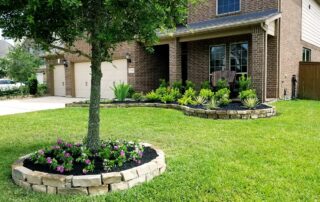How Thick Should Mulch Be in Flower Beds?
Mulch is an excellent method to keep your flowers safe, but how thick mulch should be used in flower beds? Ideally, the mulch layer should measure two to four inches thick. A thinner layer will not provide enough protection. If the soil is too low, it may prevent water from reaching the roots.
The clippings of grass
You can improve the appearance of your flower beds by using grass clippings to make mulch. They're more sustainable than straw and free. They also supply the necessary moisture and provide insulation to your plants, which reduces evaporation. Clippings of grass are an excellent source of nitrogen that will improve the soil. They are able to be used for mulching flowers up to 2 inches thick.
Grass clippings contain one to two percent nitrogen, 0.3% phosphorus, 1.3% to 2.3% potassium, and trace elements. The grass clippings can be used as fertilizers. Make use of the clippings in various landscaping tasks, such as flowers, gardens, and lawns.
The best method of using grass clippings in the flower gardens is to compost them instead of raking them into the ground. The clippings will break down faster and provide more nutrients to the soil.
Leaves
Leaf mulch adds a variety of nutrients to soil. They supply soil microbes the ability to supply them with nutrients continuously and a well-balanced mix of carbon and nitrogen. Shredded leaves are able to enrich soil with nutrients and act as natural pest control by blocking weeds as well as keeping soil moist and preventing the growth of weeds.
Using leaves as mulch is free and simple. It is crucial to first cut the leaves into pieces. This will help the mulch break down more effectively and also looks better. This helps prevent the soil from getting damp by preventing the growth of mats. Shredded leaves will also fall apart faster.
Although leaves that are whole can be attractive, infiltration problems can occur. If not shredded, they can form a mat and prevent water from getting into the soil. They also contribute to acidity and could contain substances which are harmful to various plants.
Pine needles
If you're looking for a simple way to add mulch to your garden beds, consider using pine needle mulch. It's not just a way to suppress weeds, it will increase soil porosity and provide nutrients to your soil. It's also incredibly easy to rake up. It's essential to use an area of pine needle mulch that is at least 2 to 3 inches thick. Thick layers will prevent plants from growing in the mulch.
Another reason to use pine needle mulch for your flower beds is overwinter protection. It is recommended to spread the mulch out several inches around the plant's base to guard the roots. It is also possible to pile pine needles four or five inches thick over the trunks or trees.
Pine needles are a wonderful option for flower beds due to the fact that they don't compact the soil. They also prevent weed seeds from germinating, and they are broken down slowly. It isn't necessary to be replaced every year. Plus, they are much lighter than most other mulches, which makes them ideal for gardeners.
Compost
It is a great soil amendment. It can be added in spring or fall. It can enrich your soil and help you plants grow better. Compost should be applied at a depth of 12 inches. The soil should be moist prior to adding compost. You can check the moisture level of the soil by squeeze it. If it is able to squeeze out water, it's damp.
The best compost is one that is completely decomposed. The compost is dark brown it is crumbly and has an earthy odor. It is able to improve soil structure by removing the heavy soil, and also adding body or texture to soils that are lighter. It will also provide nutrients that enhance the development of all plants, including flowers. It should take at least three months for the decomposition process to complete and at maximum three years. Compost that is not fully decomposed shouldn't be applied to flower gardens.
You can add compost to soil anytime of the year. However, it's recommended to do so during the months of spring and autumn following cleaning up the garden. Half-inch to one-inch of compost can be added to flower beds and other garden areas. It's best to distribute it around the base of the plants and at least 2 inches in between rows. If you plan to incorporate compost into your the flower beds, be sure that you spread it over the soil at least once a year, and you should see the benefits within some years.

